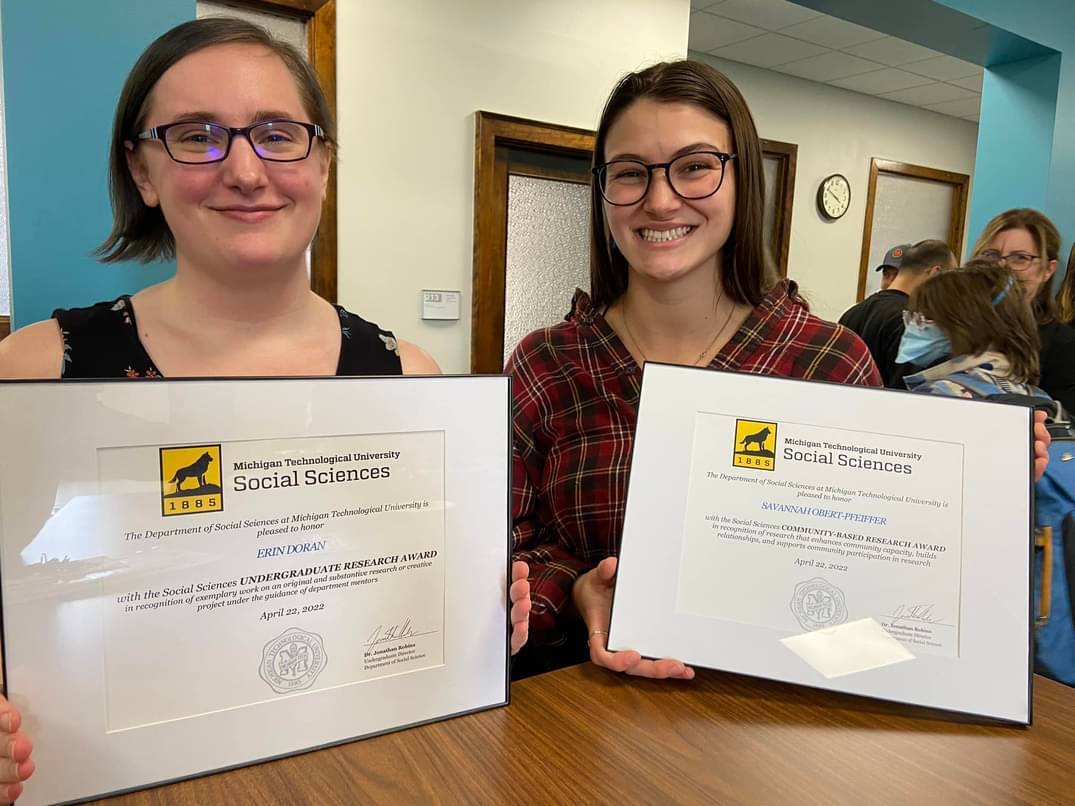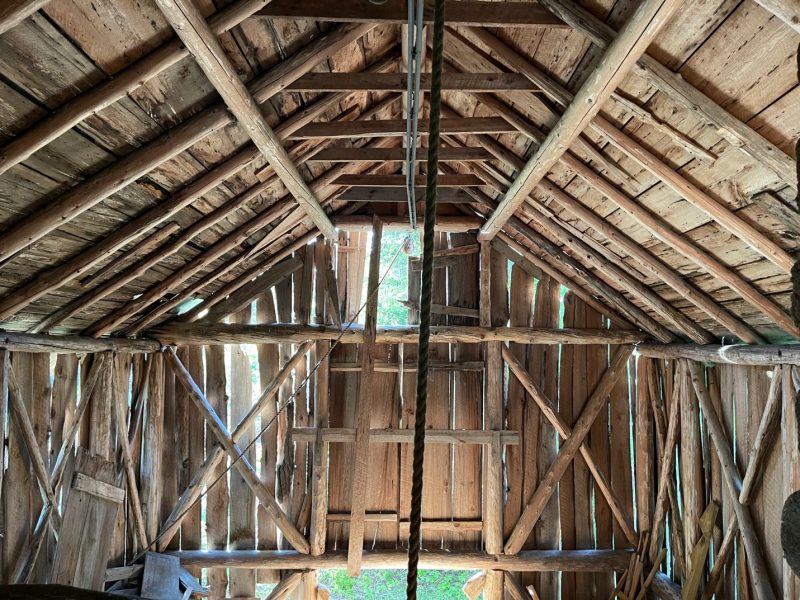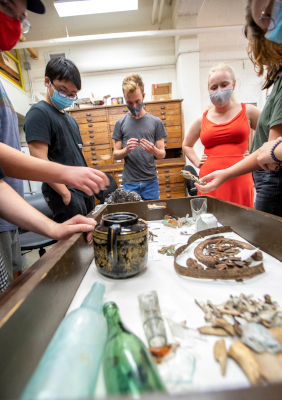A great write-up on Michigan Tech Global Campus News by Shelly Galliah on why engineers need to understand Public Policy – with insights from Dr. Adam Wellstead, Social Sciences faculty member and advisor for MTU’s new Online Graduate Certificate in Public Policy. https://blogs.mtu.edu/globalcampus/2022/10/public-policy-and-engineering/
Summer Field School includes 8 students from Michigan Tech and Northern Michigan; 3 Instructors; 3 generations of property owners; 6 visiting heritage professionals; 5 great days on the banks of Lake Superior; PLUS a dog and a resident turkey (!) all combined for an exciting place-based learning experience!
What does MTU History Associate Professor of History Sarah Fayen Scarlett get when she takes on leadership of the 2024 Vernacular Architecture Forum (VAF) annual conference planning committee? Well, perhaps a few headaches between now and 2024. But also, several unique opportunities to engage in local fieldwork documenting everyday buildings and their cultural meanings for people in the Keweenaw—past, and present. She’s sharing the opportunities this responsibility brings with Upper Peninsula students and professionals. Together they’re working on publishing a conference guidebook featuring local vernacular architecture and conference tour sites. Themes include exploring cultural identity, environmental change, industrial communities, and contemporary heritage practice. Scarlett’s “Barns and Beaches” field school gave upper peninsula college students a great applied learning experience.

Barns and Beaches Field School Uses the Keweenaw Community As A Classroom
The Summer Field School attracted students in a variety of fields such as history, anthropology, folklore, and material culture studies. The June class included two Michigan Tech Social Sciences majors, an incoming Industrial Heritage & Archaeology grad student, four Northern Michigan University anthropology students, and an MTU graduate student as a teaching assistant. The four-week 3-credit course was team-taught by Scarlett, Keweenaw National Historical Park Historical Architect John Arnold (Industrial Heritage PhD 2017), and Finlandia University Finnish Studies Associate Professor and folklorist Hilary Virtanen. The instructors contributed their expertise in documenting everyday buildings and cultural landscapes. They mentored students in the collection of information from people associated with such places.
The group of eleven formed an instantly cohesive team. Their skills and interests were well-matched for the task at hand: to document and create materials describing a Finnish American homestead farm in the Misery Bay area of Toivola and an adjacent summer cottage built in the 1940s. Both properties had remained in the families that established them.
Students Develop Field Work Skills

During the second week, the class met at the Kemppa farm in Misery Bay, Toivola. Students camped in the farm’s front pasture, thanks to the owner and steward of the property’s heritage Luann Hayrynen. This made it convenient for students to document the Kemppa family farm and the neighboring summer cottage, Dell Shack. This intensive fieldwork was augmented by a visit to the Hanka Homestead Farm, a Finnish American homestead farm museum in Baraga County affiliated with the Keweenaw National Historical Park (KNHP) as well as lecture and demonstration visits from area professionals including KNHP staff historian Jo Holt, landscape architect Steve DeLong, Park superintendent Wendy Davis, and MTU’s geospatial scientist Dan Trepal.
Students and instructors precisely measured, photographed, and created field drawings of buildings. They conducted oral history interviews of occupants and their family members to gain insights into the history of the sites’ developments over time and their cultural significance to the families and their neighbors. And they investigated materials offered for examination by the study participants, including family photographs and documents that helped solve building history mysteries. All of this activity generated a vast amount of data. Over the final two weeks, students converted raw data into computer-generated architectural floor plans of each selected building. They deepened their understanding of the properties’ histories with creative research with archival documents, deep geological and cultural historical data, and even aerial and satellite photographs of the Misery Bay area over time.
Read about Robert Hazen’s experience as an undergraduate student in the Summer Field School
Students Present Findings to the Local Community
Students acquired skills in historical architecture documentation and interpretation. They learned to conduct semi-structured oral history interviews. And they wrote interpretive content for use in the 2024 VAF guidebook. The first week centered on intensive readings, lectures, and in-class fieldwork skill-building activities in the Archaeology Lab. One highlight was a virtual visit from Professor Emerita Carol MacLennan on Indigenous land use in the Keweenaw.
During the final week of class, students prepared a group presentation of their findings for local community members at the Misery Bay School. The goals of this culminating event were to spread the word about the upcoming conference and our work at the Kemppa Farm and Dell Shack, but also to have another opportunity to learn more about these properties from people who have their own important perspectives: long-term neighbors. As a result, many stories and memories were shared over refreshments between students, property owners, and neighbors. These relationships will continue to develop as preparation for the VAF conference continues.
For more information about or to participate in the VAF conference in 2024 please contact Dr. Scarlett at sfscarle@mtu.edu.
Check out Dr. Chelsea Schelly’s sustainability blog post about Social Sciences’ new MS degree program in Sustainable Communities.
https://blogs.mtu.edu/sustainability/2022/09/19/new-ms-in-sustainable-communities/
The Department of Social Sciences (SS) would like to recognize the following outstanding undergraduate and graduate students. These awards were recently presented at the departmental end-of-year celebration on April 15th. Honors were extended for excellence in academics, research and teaching.
Graduate Awards
- Outstanding Graduate Student Teaching Award: Shardul Tiwari (Fall 2021) and Jess Applin (spring 2022)
- Graduate School Dean’s Award for Outstanding Scholarship: Talva Jacobson
Undergraduate Awards
- MTU’s Outstanding Future Alumni Award: Robert Hazen
- Social Sciences Departmental Scholar Award: Maya Klanderman
- Social Sciences Outstanding Senior Award: Madelina DiLisi
- Social Sciences Undergraduate Research Award: Erin Doran
- Social Sciences Community-Based Research Award: Savannah Obert-Pfeiffer
- Social Sciences Community-Based Research Award: Maya Klanderman
Well done to all our incredible students!
Erin Doran and Savannah Obert-Pfeiffer
Dr. Steven Walton presented a paper on “Allied Expositionary Forces: War Trophies in America after the Great War” at the Society for Military History conference in Fort Worth, TX on April 29. The work is an extension of the WWI centenary activities developed on campus in 2018 (World War One and the Copper Country) and his work for the edited book, Home Front in the American Heartland: Local Experiences and Legacies of WWI (Cambridge Scholars Publishing, 2020)
Dr. Angie Carter was interviewed and her research featured in the Daily Yonder article “Despite Legal Challenges, Women Still Face Barriers to Inheriting Farmland” by Sarah Melotte. The story will also be featured in the Daily Yonder’s weekly podcast, The Yonder Report, the week of May 2nd, 2022.
Hongmei Lu ’20 (Ph.D., environmental and energy policy) and Shan Zhou (SS) have published a co-authored paper in the Journal of Asian Public Policy.
The paper is titled “Using policy goal ambiguity to manage policy goal conflicts: Sponge-City Program implementation in old neighborhoods.”
The paper uses a case study to understand how local policy implementers take advantages of policy goal ambiguity to maximize the policy outcomes of urban stormwater management program in China, given constrained resources and budget.
A collaborative research team’s work on energy sovereignty has recently been published in the Routledge Handbook of Energy Democracy. Co-authors of “Energy democracy in practice: Centering energy sovereignty in rural communities and Tribal Nations” include Chelsea Schelly, Valoree Gagnon, Andrew Fiss, Elise Matz, Rebecca Ong and Kathy Halvorsen of Michigan Tech, along with Douglas Bessette, Laura Schmitt Olabisi and Kristin Arola of Michigan State University.
Learn more about the work via the Michigan Tech Digital Commons.
Adam Wellstead is the lead author of a study published in Current Opinion in Environmental Sustainability.
The paper, titled “Finding the sweet spot in climate policy: balancing stakeholder engagement with bureaucratic autonomy,” discusses the role of bureaucratic autonomy and stakeholder engagement in the climate change policy process and the “sweet spot” between both — which differs from country to country depending on administrative tradition and policy style.
Robbert Biesbroek of Wageningen University in The Netherlands is a co-author of the paper.
Houghton, MI (January 20, 2021) – The National Endowment for the Humanities (NEH) announced $24.7 million in grants for 208 humanities projects across the country. Michigan Technological University’s Department of Social Sciences Chair and Associate Professor of Geography and GIS Dr. Don Lafreniere and Senior Geospatial Research Scientist Dr. Dan Trepal received more than $74,000 for The Hamtramck Historic Spatial Archaeology Project.
Drs. Lafreniere and Trepal will serve as project co-PIs along with Wayne State Department of Anthropology Chair Dr. Krysta Ryzewski. Greg Kowalski, the Executive Director of the Hamtramck Historical Museum, and the Hamtramck Historical Museum’s Board of Directors will also collaborate on the project. The grant will fund Michigan Technological anthropology graduate students to assist with the 18-month project, which is scheduled to begin in June 2022.
The Hamtramck Historic Spatial Archaeology Project received NEH funding from the Preservation Access Research and Development Grant Program to support the early-stage development of a Historic Spatial Data Infrastructure (HSDI). This project will be among the first attempts to link archival, archaeological, and geospatial data across time and space. The HSDI will be designed to remedy disconnections between historical and archaeological data sets. These disconnections between different forms and types of data pose significant shortcomings for examining the histories of less visible, historically underrepresented communities, whose traces tend to survive more prominently in the archaeological record. This is especially the case in Metro Detroit, a region shaped by prominent processes of industrial expansion and urbanization over the past century. For Hamtramck and Detroit’s historically marginalized and underrepresented communities, this lack of data integration reinforces long-standing barriers to access and exclusion from cultural heritage narratives.
Over the course of the project, the Hamtramck Historic Spatial Archaeology Project team, including MTU Industrial Archaeology and Heritage students, will produce a prototype HSDI based on the case study of the Old Hamtramck Center site, where Wayne State University archaeology students have been conducting excavations since 2018. The Hamtramck HSDI will result in the creation of a prototype open-access digital deep map of Hamtramck. The HSDI and the digital deep map will demonstrate how seemingly disparate strands of historical knowledge can be evaluated, integrated, and represented in a digital, open-access format. This open-access digital deep map will improve public access to cultural heritage information, preserve digital data, and establish an advanced mode for organizing and analyzing historical and archaeological data.
“Archaeologists and historians are increasingly using digital methods for collecting and working with information about the past, but we have still barely scratched the surface of what is possible – especially when it comes to working with both archaeological and historical information together,” observed Dr. Trepal. He continued “The Hamtramck Historic Spatial Archaeology Project is a wonderful opportunity to link together several different kinds of historical and archaeological evidence, in a digital, spatial environment, to create something greater than the sum of its parts. It is all about pushing the envelope in how we use digital technologies to tell stories surrounding a place and community from multiple dimensions, for scholarly research and also for collaborating with the public.”

The first phase of the project in 2022 coincides with the 100th anniversary of Hamtramck’s founding as a city in 1922. The city and the museum are planning major commemorative events throughout the year and the project team will participate to help attract new audiences into the Hamtramck Historical Museum, engage them in conversations about Hamtramck’s immigrant and working-class heritage, and promote the role of historical and archaeological data in contributing to its preservation.
To learn more about the Hamtramck Historic Spatial Archaeology Project, contact Dr. Lafreniere at djlafren@mtu.edu and Dr. Trepal at djtrepal@mtul.edu.

